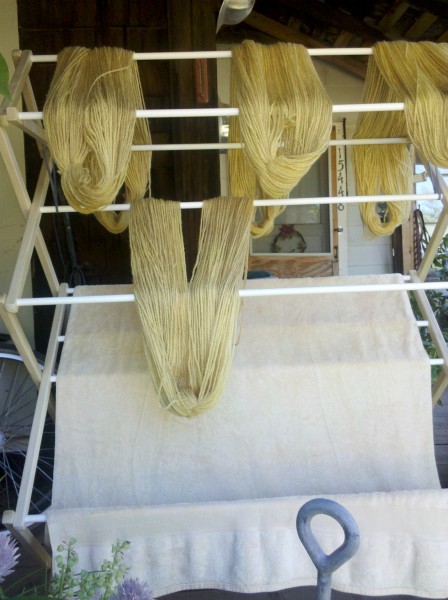Rhubarb Season
Rhubarb (Rheum rhabarbarum) is one of the harbingers of spring in most parts of the US, and grows well in many temperate regions. It is a long-lived perennial that sends up bright red stalks and enormous, deep green leaves year after year after year. In fact, I have some plants at my high country home that were there when we arrived in 1986, and are probably several decades old now. This spring has been long, cold and wet, but hasn’t stopped this prolific plant. The worry is usually to get the stalks before the plant sends up its big flowers, after which the leaves whither and die and one must wait for another year. Rhubarb jam and rhubarb crisp have been very popular in my family over the years; in fact probably DH’s favorite preserve. The leaves are very high in oxalic acid and toxic, which makes it all the more amazing that the bright red stalks are safe and delicious!
Yesterday, I got to spend part of the afternoon harvesting leaves to mordant skeins for the CSA subscribers. The wool is from the Perendale flock of the Pit River Wool Company, in my fibershed region to the northeast. Here’s a brief recap:
First, I want to say that rhubarb is a pretty stinky mordant, and more toxic than some will want to work with. However, it can be grown in so many places that it is worth considering as a local mordant. Keep in mind that working with this plant and other toxic materials points out why you want to follow all those cautions you read about:
1. Use your dye equipment only for dyeing and keep it stored away from your cooking pots.
2. Use rubber gloves! My local cooperative offered some heavy-duty nitrile ones this spring that fit me well, and I have relied upon them!
3. Work in a very well-ventilated area.
4. Plan for how you will dispose of wastes. The mordant bath should ‘use up’ all of the oxalic acid, but you will still want to know what to do with your waste water. In my case, I have enough room that I can use an area for filtering the dilute dye bath through the clay soil here.
I used the recipe in Jenny Dean’s Wild Colour, and simmered my pot of plant material while busy with chores in another part of the house… also, several doors and windows open! Then, I mordanted skeins and have so far made enough mordant bath for two pounds of wool, and treated one pound. Rhubarb added a slight color to the yarn, which will make it a very interesting yarn to experiment with overdyeing. That is one of the reasons why I chose to include it as a pre-mordanted yarn for my subscribers; so they could get experimental, even though rhubarb is only advised for use fresh, and only available once a year!
Marta, who sold me the wool, dyed her’s a few weeks ago and had a slightly greenish-yellow; in my case, the color is more a yellowish-cream. Either way, I can think of fantastic possibilities to modify osage orange, madder, even indigo (though it doesn’t need a mordant!).
I could brew up another batch and save the mordant liquid for future use, however I don’t want oxalic acid sitting around, and like the fact that I can only have the one opportunity a year. Kind of like eating rhubarb crisp (although there is some chopped and frozen for next winter!)
Rhubarb Crisp
Chop enough rhubarb (stalks only!) into 1-inch dice to fill your deep dish pie pan or 1 1/2 quart casserole, and toss with the juice of one lemon. Mix 1 tbsp. cornstarch, 1/2 cup sugar, 1/4 tsp. cinnamon and 1/4 tsp. cardamom; stir into the rhubarb, and even out.
Separately, mix with your fingertips until crumbly 1 cup flour, 1/2 cup brown sugar, pinch of salt and 6 tbsp. cubed unsalted butter. Sprinkle this topping over the rhubarb mixture. Bake in 400 degree oven for 45 minutes.










Can I just say – to the dismay of everyone in my family – one of the things I really love is the cherry rhubarb appetizer at the chicken dinner place at Knott’s Berry Farm!!! YUM